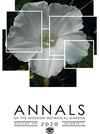葡萄、葡萄酒和医药:乔治·恩格尔曼的其他职业(1809-1884)
IF 1.3
3区 生物学
Q3 PLANT SCIENCES
引用次数: 0
摘要
虽然在专业上,他对北美仙人掌的研究更为人所知,但葡萄和葡萄酒构成了美国植物学家乔治·恩格尔曼(1809-1884)职业生涯中更长的、更重要的文化线索。通过对恩格尔曼存放在密苏里植物园的个人文件、信件和非正式的日常通信的全新和全面的利用,本文重新评估了这位植物学家在葡萄科学、国际葡萄酒工业、19世纪晚期根瘤蚜危机以及他在圣路易斯医疗实践中使用葡萄酒的历史上的地位。恩格尔曼对葡萄属植物的研究表明,他是科学探索的大车轮的中心,将美国植物学家定位为享有声望的国际观众的专家。他在三个相关领域的贡献——葡萄品种的植物学发现和命名,为葡萄酒行业服务,以及作为一名医生通过开葡萄酒处方来照顾圣路易斯家庭的健康——都是美国国家扩张的关键方面。像许多其他葡萄酒爱好者一样,恩格尔曼和他的同胞们对将美国的葡萄栽培和国家本身定义为与野生的、有弹性的本地品种和栽培的精炼有关的项目很感兴趣。本文章由计算机程序翻译,如有差异,请以英文原文为准。
Vitis, Wine, and Medicine: The Other Careers of George Engelmann (1809–1884)
Although professionally better known for his work on North American cactus, grapes and wine formed the longer and arguably more culturally important thread of U.S. botanist George Engelmann’s (1809–1884) career. Through new and comprehensive use of Engelmann’s personal papers, letters, and informal daily correspondence housed at the Missouri Botanical Garden, this essay offers a reappraisal of the botanist’s place in the history of grape science, the international wine industry, and the late 19th-century phylloxera crisis, as well as the use of wine in his medical practice in St. Louis. Engelmann’s work on Vitis L. illustrates that he served as the hub of a wide wheel of scientific inquiry, positioning U.S. botanists as experts for prestigious international audiences. His contributions in three related arenas—botanical discovery and naming of Vitis species, service to the wine industry, and as a physician attending to St. Louis families’ health by prescribing wine—were all crucial facets of U.S. national expansion. Like many other wine enthusiasts, Engelmann and his adopted countrymen were interested in defining U.S. viticulture and the nation itself as projects concerned with both wild, resilient native stock and cultivated refinement.
求助全文
通过发布文献求助,成功后即可免费获取论文全文。
去求助
来源期刊
CiteScore
3.60
自引率
0.00%
发文量
15
期刊介绍:
The Annals of the Missouri Botanical Garden is a quarterly international journal primarily devoted to systematic botany and evolutionary biology. We encourage submissions of original papers dealing with significant advances in the taxonomy, phylogeny, biogeography, paleobiology, and evolution of plants, and in conservation genetics and biology, restoration ecology, and ethnobiology, using morphological and/or molecular characters, field observations, and/or database information. We also welcome reviews and papers on conceptual issues and new methodologies in systematics. Important floristic works will also be considered. Symposium proceedings discussing a broader range of topical biological subjects are also published, typically once a year. All manuscripts are peer-reviewed by qualified and independent reviewers.

 求助内容:
求助内容: 应助结果提醒方式:
应助结果提醒方式:


